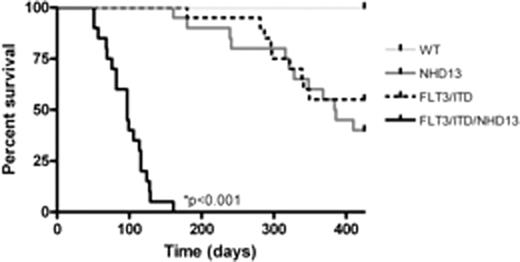Abstract
Abstract 2961
Poster Board II-937
Constitutive activation of FMS-like tyrosine kinase 3 (FLT3) by internal tandem duplication (ITD) is one of the most common molecular alterations in acute myeloid leukemia (AML), and provides a proliferative and survival advantage to leukemic cells. We have previously generated a knock-in mouse in which an 18-bp ITD mutation, isolated from a patient with AML, was inserted into the juxtamembrane domain of the murine FLT3 gene. Heterozygous FLT3WT/ITD mice develop a myeloproliferative disease, which progresses to mortality within 6 to 20 months. However, no sign of acute leukemia is observed over the lifetime of these mice, indicating that additional cooperating genetic events are required for leukemic progression. FLT3 activating mutations have been seen in MDS in about 5% of cases and an additional 5% of patients with MDS acquire FLT3 mutations as they progress to AML. One model of MDS has been developed by transgenic expression of the NUP98-HOXD13 (NHD13) fusion under the vav promoter. Mice expressing the NUP98-HOXD13 (NHD13) transgene develop a highly penetrant myelodysplastic syndrome (MDS) with about 50% eventually progressing to acute leukemia by 14 months. We wanted to generate a mouse model to see if FLT3/ITD mutations would cooperate with the NHD13 fusion to progress to overt leukemia. Double mutant mice (FLT3/ITD/NHD13) were generated by crossing heterozygous FLT3WT/ITD mice with mice expressing the NHD13 transgene. Strikingly, FLT3/ITD/NHD13 offspring (n=40) developed an acute leukemia with 100% penetrance and a median survival of 97 days. In contrast, NHD13 (n=20) and FLT3WT/ITD (n=20) littermates had median survivals of 385 and 410 days, respectively (Figure 1). Differential cell counts at the time of sacrifice showed elevated peripheral white blood cell counts in the double mutant mice (161.0±50.6 k/μl) compared to three-month-old wildtype (12.5 ±5.0 k/μl), NHD13(3.2 ±1.0 k/μl), or FLT3WT/ITD (7.9 ±3.5 k/μl) littermates. Organ sectioning and histological staining of double mutant mice showed leukemic infiltration of the spleen, liver, and brain. FLT3/ITD/NHD13 offspring developed a heterogeneous group of acute leukemias, with 46% developing ALL, 39% biphenotypic leukemia, and 15% AML as diagnosed by flow cytometry of the bone marrow and spleen. Transplantation experiments showed that the leukemia was able to engraft in lethally irradiated recipients, with disease occuring within 30 days post-transplantation. The disease was transferrable with as few as 1000 cells, and this ability was restricted to the B220+Mac-1−Gr-1- population. In order to identify the changes in gene expression responsible for leukemic transformation, RNA was isolated from the total bone marrow of young FLT3/ITD/NHD13, wildtype, NHD13, and FLT3WT/ITD littermates prior to the development of discernable disease and probed for over 43,000 coding and non-coding mouse sequences by Agilent 44K array. The rapid onset of acute leukemia in this model indicates the collaboration between hox gene dysregulation by a chromosomal translocation and altered signaling through the FLT3 receptor. In addition, since resistance to FLT3 inhibitors alone remains an important clinical issue, gene expression profiling of leukemic cells may help identify new molecular targets in collaborative signaling pathways.
Disclosures:
No relevant conflicts of interest to declare.
Author notes
*
Asterisk with author names denotes non-ASH members.
© 2009 by The American Society of Hematology
2009


This feature is available to Subscribers Only
Sign In or Create an Account Close Modal